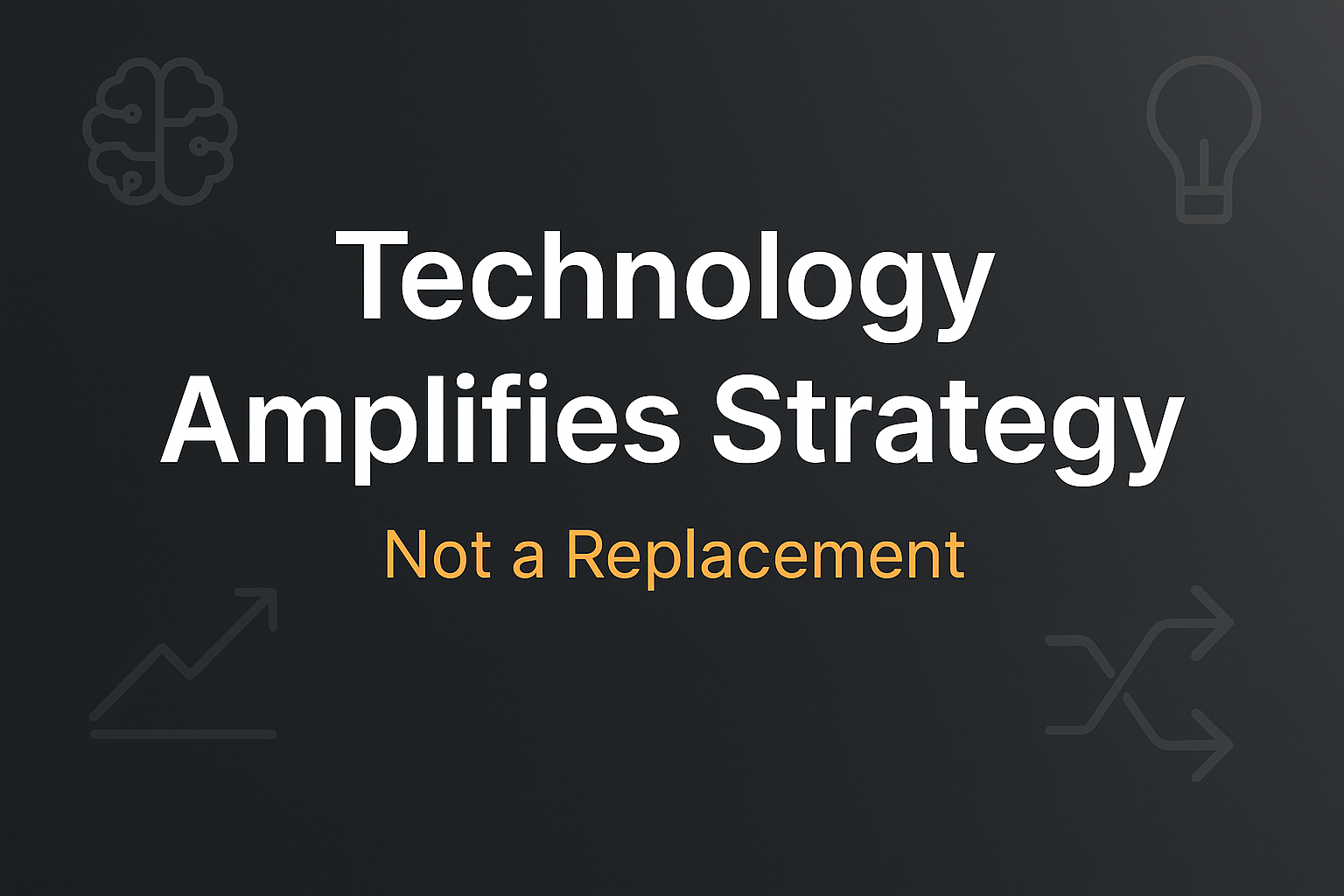Technology is evolving faster than most teams can keep up. From AI copilots to predictive analytics, leaders are promised efficiency, clarity, and competitive advantage. Yet too many assume tech itself is the strategy.
Here’s the truth: technology amplifies good strategy — it doesn’t replace it. Without clear thinking, automation simply accelerates confusion.
The Automation Mirage
What most SMEs do
They invest in every trending platform — CRMs, AI assistants, data dashboards — expecting instant growth.
Why it backfires
- Stack sprawl: overlapping tools with no cohesive goal.
- False comfort: dashboards create the illusion of control, not understanding.
- Shallow insight: data becomes noise when leadership lacks focus.
As Adobe’s 2025 Digital Trends Report highlights, 72% of high-performing brands say their advantage comes from “clear digital vision,” not volume of technology.
Related reading: Outpaced by Complexity: Why Digital Growth in SMEs Is About Focus, Not More Tech.
Technology as a Force Multiplier
High-growth businesses use technology as an amplifier of intent, not a replacement for it.
| Principle | What Most Brands Do | What Effective Brands Do |
|---|---|---|
| Tool Use | Automate tasks reactively | Design systems that align with strategy |
| Data | Collect everything | Measure what matters to growth |
| AI Adoption | Replace decisions | Enhance decision speed and accuracy |
| Leadership | Delegate to tech | Guide tech with vision and clarity |
Example: A travel brand using predictive analytics without a clear pricing strategy just automates the wrong prices faster. But when analytics are shaped by a defined margin framework, tech becomes a multiplier.
The Strategic Thinking Gap
Technology fails not because it’s weak — but because teams misuse it.
- AI tools can’t define goals. They only execute on the clarity you provide.
- Automation scales intent — good or bad. It magnifies inefficiency when direction is fuzzy.
- Tech literacy ≠ strategic capability. You can master GA4, but still misread what success looks like.

As someone who has led digital growth across travel, health, and DTC brands, I’ve seen this first hand. The best results come when leadership starts with “why” — not “what tool.”
Building Strategy That Tech Can Amplify
1. Start With Vision, Then Translate to Systems
Define the growth outcomes (margin, retention, efficiency). Only then select tools that reinforce them.
2. Simplify Before You Scale
A fragmented stack drains focus. Streamline data sources and workflows before automating anything.
3. Create Rituals for Decision-Making
Weekly trading reviews, campaign retros, and analytics syncs ensure tech output drives real action.
4. Elevate Digital Literacy at the Top
Strategic thinking is a leadership skill. Train decision-makers to ask smarter questions, not just read dashboards.
Case Example: Focus Over Features
A consumer brand automated its email sequences across six tools, chasing “personalisation.” Engagement dropped 30%.
The fix? They simplified to one CRM, rebuilt journeys around customer intent, and reintroduced human review for key touchpoints. Within two months, retention rose 24%.
Lesson: Strategy gives automation purpose. Without it, even the smartest tech becomes noise.
FAQ
- Does technology replace the need for a clear strategy?
- No. Tools amplify what already works. Without a clear strategy and ownership, technology just makes noise faster.
- How do we decide which tools to adopt?
- Start with the goal and constraints. Define the outcome, metrics, and process first—then choose the tool that removes the biggest bottleneck.
- Where should AI fit in our plan?
- Use AI to speed research, summarise insight, and automate repetitive tasks. Don’t let it set strategy—let it execute parts of it.
- What are the signs our strategy is missing, not our stack?
- Lots of tools, little movement. Conflicting priorities, ad-hoc projects, and no single owner for key metrics are the giveaways.
- How do we measure if tech is actually helping?
- Track a small set of outcomes tied to the strategy: qualified traffic, conversion rate, CPA/CPL, repeat rate. If a tool doesn’t move one of these, cut it.
- When should we invest in new platforms?
- After you’ve proven the process with existing tools and hit a ceiling. Upgrade to remove a clear constraint—speed, scale, or precision—not for feature lists.
Conclusion
Technology’s power lies in amplification. When strategy is clear, tech multiplies results. When it’s missing, it multiplies mistakes.
SMEs that prioritise thinking over tools will win the next wave of digital growth — not by having the most automation, but by applying it with intent.
Want to build a strategy that technology amplifies — not replaces? Book a discovery call with Mostly Grey Digital and bring clarity to your next stage of growth.
Key Takeaways
- Tech amplifies clarity, not confusion.
- 72% of top performers succeed through strategic focus, not tool volume (Adobe, 2025).
- Streamline stacks before scaling automation.
- Build rituals where data informs action, not paralysis.
- Invest in leadership clarity — it’s the ultimate growth multiplier.
